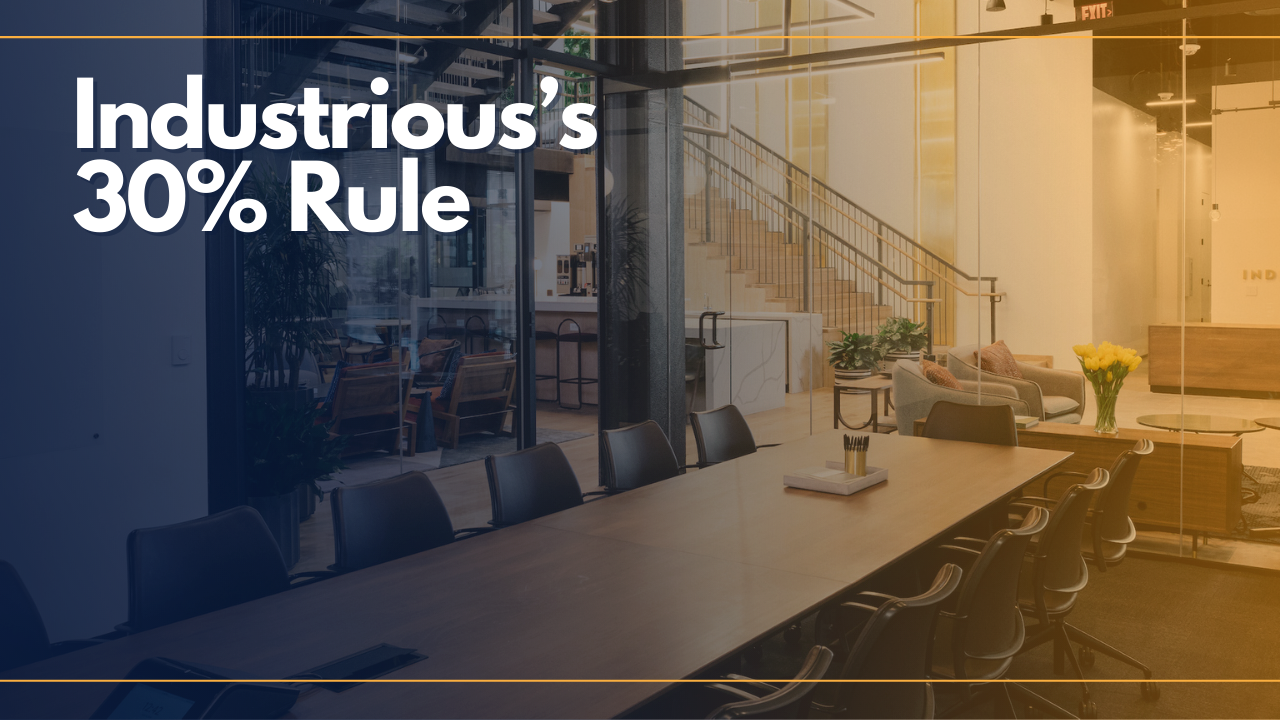- As companies analyze ways to bring workers back to the office, flexible office brand Industrious recommends a 30% model.
- Surveying employees every 30 days, bringing in 30% of people, and waiting for 30% of staff to be vaccinated are just some of its suggested rules.
- This model enables companies to gradually transition from home to hybrid, and enable employees to benefit from both remote and in-office time.
Industrious recently published The 30% Rule: Planning Your Team’s Return to the Office, a guide that is intended to help support organizations transition from fully-remote to a hybrid workforce.
The guide provides a framework with actionable steps that companies can take to ensure a smooth transition back to the office.
In the guide, Industrious argues that “the office we return to should be less like a classroom with neatly lined rows of desks and more like a student center — a magnet of social activity, connection, and collaboration.” This type of workplace can better support remote and in-person employees by allowing for worker interactions to be actively managed.
So, how should your company approach transitioning to a hybrid workplace?
Industrious’s 30% Rule
Industrious came up with the 30% rule, which goes as follows:
- Survey team members every 30 days to evaluate performance.
- Bucket employees into two groups:
- 30% in-office / 70% remote work
- Or, 30% remote / 70% in-office
- Modify up to 30% of your existing office floor plan to better suit your team’s current needs.
- Resume in-office operations when 30% of staff is vaccinated.
Let’s take a deeper look into each rule.
Pro tip: “Workplace strategies should be frequently reevaluated so that companies can achieve outcomes centered on employee choice and satisfaction.”
Evaluating Performance
This step is important to understand what is working and what isn’t for your company and staff.
Keep in mind that employees likely already have a vision of how and where they prefer to work moving forward; before you set out any plans and implement any strategies, it’s important to take these visions into consideration.
Part of this evaluation should include grading your company’s remote work performance. For this, Industrious recommends that organizations focus on understanding every employee’s perspective on how working from home has impacted her or his ability to:
- Contribute individually
- Collaborate and brainstorm with others
- Communicate with others
- Mentor or be mentored
- Develop a sense of community and team culture.
To encourage workers to want to come back to the office, it’s important that you first understand their preferences. To evaluate and re-evaluate performance, gather information through:
- Surveys
- One-on-one interviews
- Focus groups
- Team meetings.
A Hybrid Workforce
As companies plan the return to the office, it’s unlikely that they will bring back all workers at once.
Rather, companies will likely implement a hybrid approach that allows for workers to work remotely and in-office. To figure out which workers should remain remote and which ones should come to the office more often, consider mapping team members to different work styles:
- Collaborators
- Connectors
- Residents
- Nomads.
Industrious categorizes the collaborators and residents as static workers, meaning they require resources in the office and in-office interactions. These types of workstyles are generally more productive in the office vs remotely.
Connectors and nomads, for their part, are mobile workers that often move between workspaces. They are as productive working remotely as they are in the office.
Beyond work styles, organizations should also take into consideration the following when determining who will work remotely and who will work from the office:
- Personality and personal circumstances
- Type of work
- Team culture and management
- Employee experience and tenure
- Mentorship needs
- Access to technology
- Commune
- Ergonomics of home office.
Updating Your Floor Plan
While it may be tempting to reduce your company’s real estate footprint if you plan to institute a hybrid workforce, this isn’t necessarily the best course of action.
Instead of downsizing, focus your efforts on reimagining and redistributing your office space.
Most offices were designed to support individual work. In the future, work that will be done in the office will be more collaborative in nature. Therefore, you should reimagine your workplace to include more collaborative work environments.
To this end, Industrious recommends up to a 30% redistribution from individual to shared, collaborative settings that can support social engagement.
Here are some ideas to update your company’s floorplan:
- Add Modular Meeting and Phone Rooms
- Engage Employees at Entries
- Augment the Social Space
- Level-Up Individual Workspace
- Alter Conference Rooms.
Wait for 30% of Staff to Be Vaccinated
Industrious recommends companies wait until 30% of their staff is vaccinated before calling workers back into the office.
Planning for the right timing is challenging and depends on where your company is located. Despite government efforts to vaccinate people as soon as possible, it’s hard to predict when your employees will get access to the vaccine.
The good news is that it’s likely that most workers in the US and Europe will be vaccinated by the end of the year.
You can access Industrious’s 30% guide here.


 Dr. Gleb Tsipursky – The Office Whisperer
Dr. Gleb Tsipursky – The Office Whisperer Nirit Cohen – WorkFutures
Nirit Cohen – WorkFutures Angela Howard – Culture Expert
Angela Howard – Culture Expert Drew Jones – Design & Innovation
Drew Jones – Design & Innovation Jonathan Price – CRE & Flex Expert
Jonathan Price – CRE & Flex Expert














